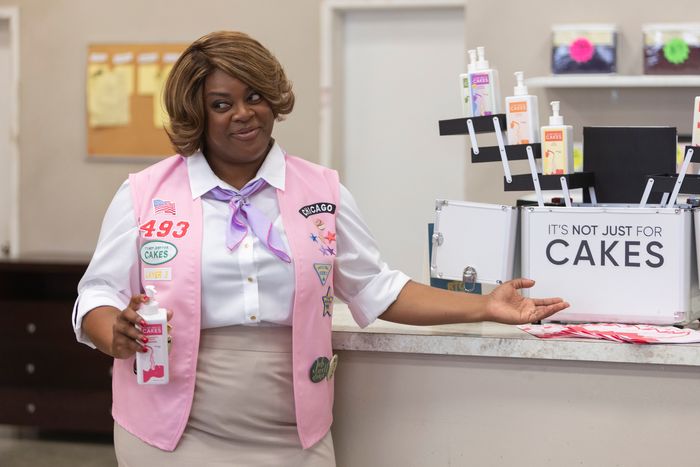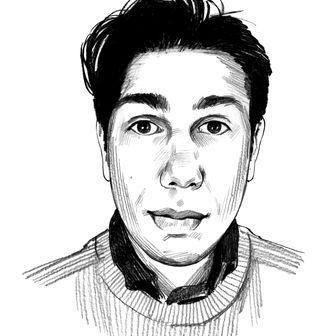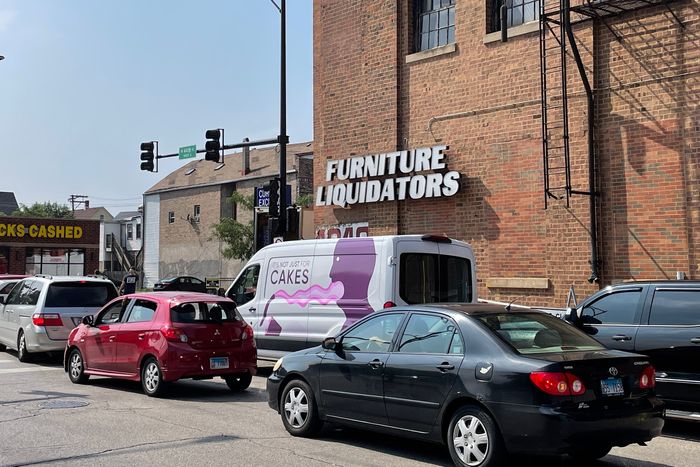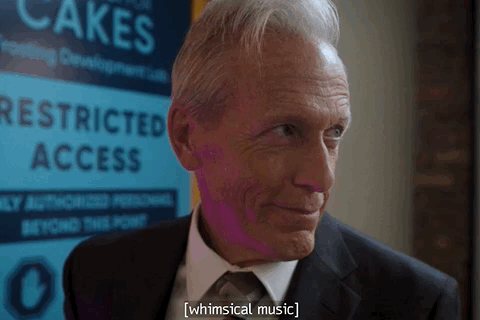
There was a peculiar-looking industrial van that drove around the South Side of Chicago between July and September 2022. It was adorned with a silhouette of a person mainlining what appears to be frosting into their mouth from a lotion bottle, and a cryptic message that read, “IT’S NOT JUST FOR CAKES.” If a commuter had Googled this in confusion, their search for answers would have come up empty, because this van is unexplainable outside of the context of one deeply mystifying subplot in season three of HBO Max’s sitcom South Side. In context, however, it is a perfect example of how the series maintains a profound devotion and thoughtful approach to silliness that makes it one of TV’s best and purest comedies.
Episode two, “College,” follows a brainwashed Kitty Goodnight (Rashawn Nadine Scott), wife of Officer Goodnight (South Side co-creator Bashir Salahuddin), who is deep in the throes of an insidious multi-level marketing cult called — as the van’s decal reads — “It’s Not Just for Cakes.” Upon witnessing Kitty trying to sell lotion bottles full of frosting by singing a frosting-themed carol and “splurting” free samples directly into peoples’ hands at a product demonstration, Sergeant Turner (Chandra Russell) cautions Goodnight about the organization’s unsavory reputation. What follows is a tour de force of comedic world-building, where the show’s entire team — creators, actors, writers, directors, and behind-the-scenes artists — construct an elaborate universe for Goodnight and Turner to dive into head-first as they investigate the cult’s inner workings. “Frostings!” or “Frostlo!” its adherents greet one another, stretching their palms outward to the sky like they’re carrying an invisible serving tray. Members dress in Girl Scouts-inspired vests complete with merit badges featuring slogans like “Frosting Addict” and “True Believer.” The mastermind behind the cult is an eccentric named Wheyland Pace (Larry Yando), who leads Goodnight and Turner on a Wonka-esque tour of the It’s Not Just For Cakes “frostquarters,” where access to prohibited areas is granted by licking-tongue scanners and they witness people studying the rousing effects of frosting in an area called the “erotic frostings room.”
The idea for this storyline sprouted from a simple pitch — “Kitty joins a cult” — that was on the board early on in the season’s writing process, Salahuddin explains. An amusing mishap the episode’s writer and director, Michael Blieden, imagined in the show’s production office one day helped nudge it towards its eventual shape. “We had all these vats around,” he recalls, referring to the office’s many hand sanitizer dispensers. “I was talking to someone and I was like, ‘Yeah, so anyway,’ and I reached over and started pumping something, and in the back of my mind I was like, That could be motor oil. I never looked at what the label said. And then later on, I was like, That’d be funny if it was cake frosting and I rubbed it on my hands. That was the basis of the product. I was like, ‘This is the dumbest thing, but what if it’s a cult that sells frosting you pump from pump bottles?’”
Blieden decided to switch gears, changing the originally envisioned cult into something that hues closer to a pyramid scheme with cult-like qualities. He drew inspiration from his experience with a multi-level marketing scheme he was once duped into attending a recruitment seminar for by a crush he’d thought had invited him out on a date. This allowed Scott and Russell to get more in touch with their characters, too: Scott says her mom used to sell Mary Kay and Cookie Lee products, and she drew from this in her characterization of Kitty; Russell recalls a disastrous experience where she tried to push a line of Avon products tailored toward young adults and just ended up with too much chapstick. “Your lips are never crusty, but you also don’t have any money,” she says.
The hypothetical Blieden envisioned where someone absentmindedly rubs frosting on their hands made it into the script, leaving the show’s production designer, Natalie Groce, to figure out how best to capture this on camera. Before any “splurting” could occur, her team had to test out multiple iterations of bottle shapes, pick the right label among the several mockups made by graphic designer Mary Hayes, and most importantly figure out what to put in the bottles to get it to pump freely without resistance. “It was a physics problem,” she explains. “It is frosting, but we had to play with the consistency of it. If it was too thick, it wouldn’t come out and do the ‘splurts.’ I think what we ended up with is more of an icing, technically.” Even the sound effect that accompanied each expulsion of frosting had to be just right. Blieden recalls a panicked 45 minutes during the episode’s sound-mixing stage where Salahuddin noticed that someone had changed the “splurt” sound effect they’d been using previously, and they scrambled to relocate the sound effect with the correct amount of wetness. “Watch it with headphones — you’ll appreciate it,” he says.
Attention to detail like this is a common thread throughout the episode. The script is filled with sweaty not-quite-puns that get funnier as the episode progresses, like “frostingverse” and “motherfrosters.” Scott, who wrote the melody for the frosting carol she belts during her product demonstration, says she tried out three different genres of the song before arriving at the one that worked best. And the show’s casting directors, Mickie Paskal and Jennifer Rudnickie, picked up on Lando’s ability to give off Mr. Burns-vibes and brought him to audition, knowing how much South Side’s showrunners love a good Simpsons homage. And just as The Simpsons is famous for including easter eggs in the background of scenes, the It’s Not Just For Cakes “frostquarters” is littered with visual references that make the world feel lived-in. Blink once and you may miss the propaganda posters hanging on the wall featuring a surreal, aged-down Pace and catchy slogans like “Frost me baby one more time.” Blink a second time and you’ll look right past the graph on the wall of the erotic-tastings room that tracks an experimental subject’s response to various frosting stimulus using an X-axis labeled “arousal” and a Y-axis labeled “performance.” “It’s really nerdy, wonky stuff,” says Riddle.
One visual joke that’s impossible to miss is the aforementioned tongue-scanner, used to authorize Pace’s access to restricted areas throughout the building. Though scripted, Blieden says, while filming, he almost had to cut the scene because it got “really complicated” to execute. It was only on Groce’s insistence — who had taken it upon herself to build a custom, light-up apparatus inspired by Chicago’s oddly shaped Crain Communications Building — that they kept it in. It was also her idea to swap the device from being a decoy retina scanner as it was written in the script to a decoy hand-scanner, arguing that it’s much funnier visually for Pace to bend down to lick the machine rather than employ it at eye level. And, of course, because of COVID-19 compliance regulations, Russell — who was acting in the scene and kept breaking — says they had to keep sanitizing the plexiglass pane Yando was licking between takes for safety.
Is It’s Not Just for Cakes a metaphor for some bigger idea? You might look at the vests created by costume designer Kenyatta Williams and think the episode is a takedown of the Girl Scouts of America. You might hear lines of dialogue like “That’s just society telling you what to put your frosting on” and think it’s a comment on people’s growing distrust of mainstream beliefs. You might see there are layers in the It’s Not Just for Cakes hierarchy and view it as a skewering of Scientology. But presented with all of these theories, Salahuddin demurs. Though he admits there are some episodes of the show that do have more of a message than others, he stresses any and all social commentary present here is entirely incidental. “I think it lessens the show a little bit when it feels like we’re going at one particular target,” he says. “We always try to shoot the widest shot possible.”
By keeping the door open to all possibilities like this, South Side is able to feel loose and improvisational, even though it is meticulous and precise. “The show is written so naturally that anything we improvise fits beautifully,” says Scott. “It’s fun to play a game of, ‘Was this written or was this improvised?’” Scott, who has a long background in improv, confirms she riffed at least one great line in the episode about a new It’s Not Just for Cakes flavor called “How Is It Any Different Than Kool-Aid?” Asked about whether she’s had any personal experiences with cults that mirror her character Kitty’s, she says no, but with a caveat: “Being involved with the improv community is the closest I’ve gotten.”





